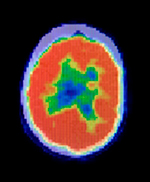
Imagine watching football and someone goes down with a head injury. Rather than wheel him off the field, they bring out a helmet for the guy!
The helmet is actually a new PET (Positron Emission Scanner) helmet and is basically a mobile PET scan for the head, which has amazing applications for head injuries. This is especially true for stroke victims because every forty seconds, someone in the U.S. has a stroke, and every four minutes, a person dies of one. Since the key to surviving is getting a quick diagnosis, the helmet would shorten that time. Paramedics could begin scanning a patient's head on the way to the hospital.
The image helps doctors determine which type of stroke occurred so they can know how to treat it. Stroke happens when blood flow to a part of the brain is disrupted by a blockage or a rupture of the blood vessel. Without oxygen, brain cells begin to die rapidly.
The helmet is the size of a motorcycle helmet. It scans like a regular PET scan and produces detailed images of the brain. Patients inhale, swallow, or have injected small amounts of radioactive materials or radiotracers. The radiotracers put out signals that an imaging PET detector then sends to a computer which integrates them into images. The radiotracers leave the body in about two to ten hours and equate to the radiation from a CT scan.
The current version of the helmet is a bit heavy. A standard one weighs 6.6 pounds and the upgraded model is a hefty 20 pounds. Scientists have come up with a way to counterweigh the load off someone's neck, however, and we imagine future versions will be a lot lighter.
More Information
Stroke Facts and Statistics
From the Centers for Disease Control and Prevention
Portable Brain-Scanning Helmet Could Be Future for Rapid Brain Injury Assessments
Stroke victims and those felled by head injuries on the sports pitch or battlefield could benefit from a new wearable scanner currently being tested...
PET Scan
A positron emission tomography scan is a type of imaging test. It uses a radioactive substance called a tracer to look for disease in the body...